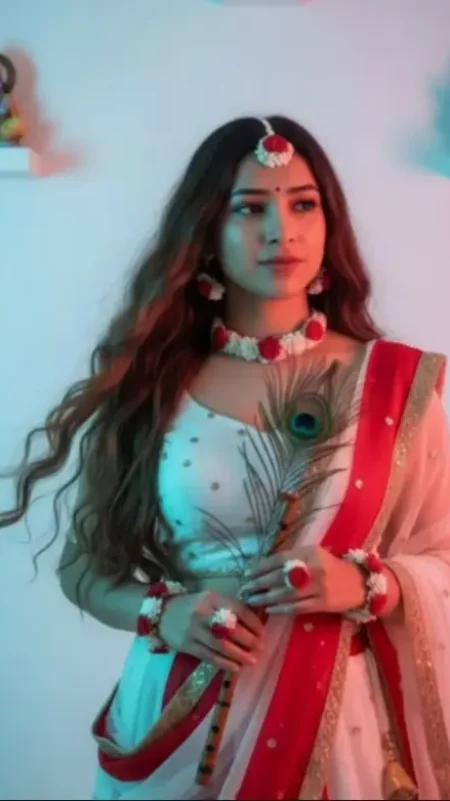
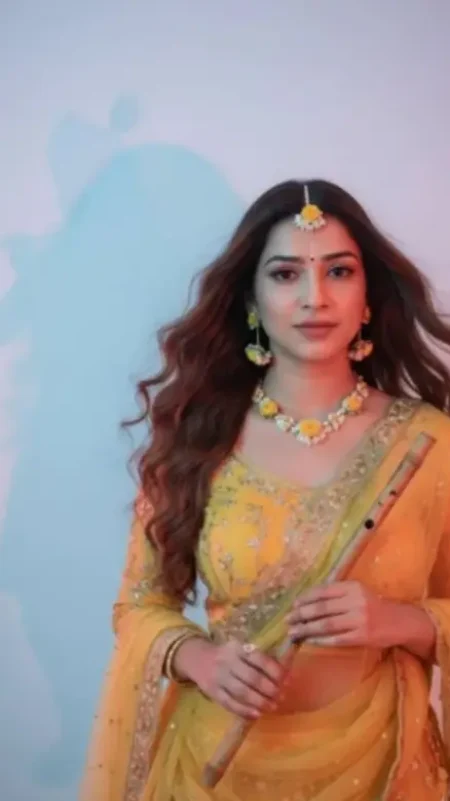
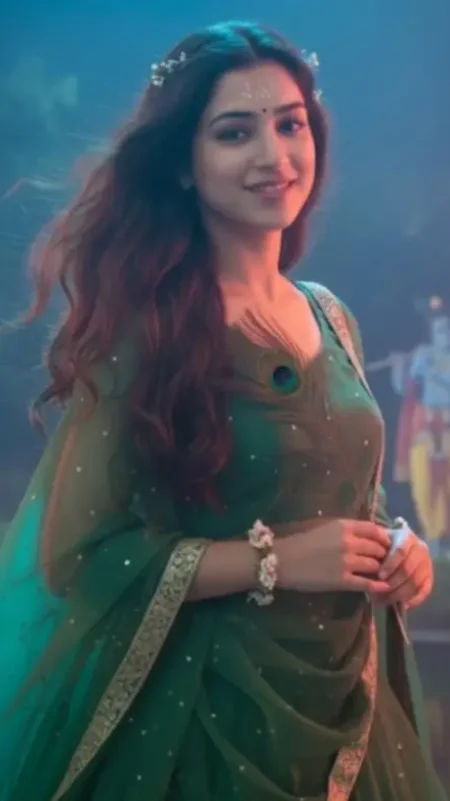
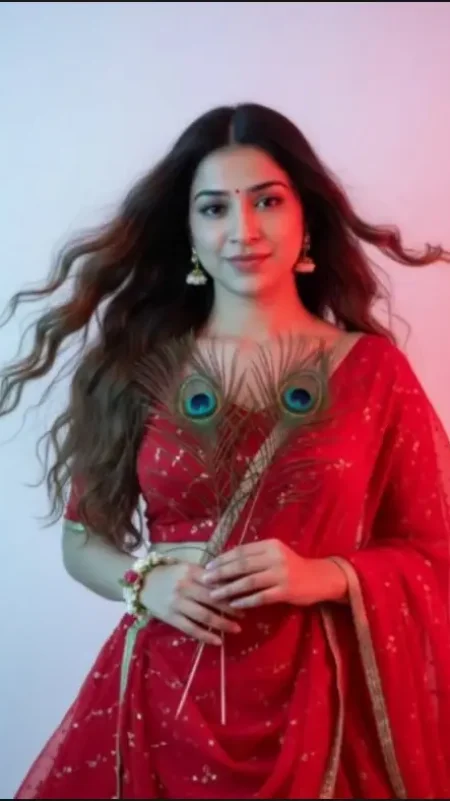
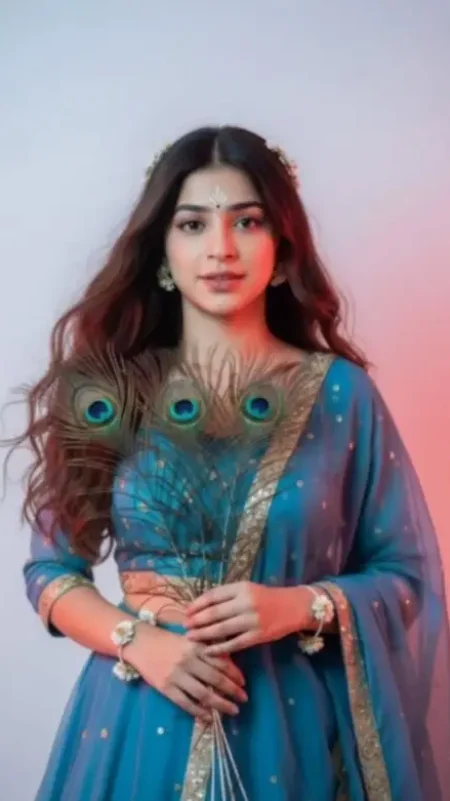
Radha’s Grace: Why This Collection Speaks
When you look at the “Radha’s Grace: Gemini Saree Prompts Collection” on GadgetPouch, what strikes you first is how each prompt is crafted not just with visual detail, but with heart. The sarees, the jewelry, the ambiance—they all come together to evoke something more than beauty. The collection doesn’t just show what a saree looks like; it tells a story. It paints Radha not just as a symbol, but as someone who could be standing right in front of you—with grace, with poise, with divine warmth. This post explores why that happens, how the prompts are built, and how you can use similar ideas to craft your own Radha-inspired portraits with Gemini.
What these prompts have in common
All of the prompts in Radha’s Grace share certain essential decisions. First, there’s preservation of identity: “Use the face from the uploaded photo exactly as it is,” which anchors realism. Then, styling choices: saree color, embroidery, bordering, florals. Accessories: maang tikka, bangles, peacock feather, sometimes the flute. Lighting and background are described in soft, glowing or gradient terms. Many call for cinematic or divine glow. The mood is serene, almost devotional. These repeated motifs give the collection coherence, so you sense it’s one curated set, not random images.
Breaking down elements of standout prompts
Take one of the prompts: “White saree with golden embroidery and bold red border, floral jewelry, flute and peacock feather, soft pink-blue gradient, Krishna idols on shelves.” Notice, there’s contrast—white & gold & red—all carefully chosen. The accessories evoke cultural mythology. The background pulls in color but gently (pink-blue gradient), has symbolic artifacts (Krishna idols) but in a subordinate role. Lighting is soft and natural. Together they feel ornate but not overbearing.
How to use this collection as a foundation
If you want to build off this Radha’s Grace set, start with one prompt from the collection. Pick what you like: color combo, accessories, background style. Then adapt small pieces. Maybe you change the saree border, or swap the flute for a lotus flower. Maybe you adjust lighting from daylight to twilight glow. The idea is not to copy, but to remix with your own vision. Each prompt gives you scaffolding.
Prompt building tips inspired by Radha’s Grace
Below are refined ideas that mirror this collection’s style:
• Always start with identity anchor: “Use the face from the uploaded photo exactly as it is.” It keeps the subject’s likeness stable.
• Choose fabric and saree color with clear specifics: “white saree with golden embroidery and bold red border,” or “dark green saree with golden motifs.” Details like border color, embroidery style matter.
• Accessorize mindfully: peacock feather, flute, floral jewelry, matching bangles. These items do more than decorate; they reference culture and myth.
• Background/light: gradient color lighting (pink/blue), calm outdoor or lakeside scenes with soft blur, silhouettes of mythological figures tucked away softly. Lighting like “divine glow” or “soft natural lighting” helps mood.
• Expression and pose: gentle smile or calm gaze works; holding props (feather, flute) adds storytelling without overcomplicating. Mid-shot portraits keep focus balanced.
Example prompts you can try
Here are a few that follow the Radha’s Grace style. You can use as is, or tweak:
“Use the face from the uploaded photo exactly as it is. Subtle retouching for skin clarity with soft natural lighting. Portrait of a woman styled as Radha in a white saree with golden embroidery and bold red border, floral jewelry in red and white, matching bangles & rings, maang tikka. Holding peacock feather and flute. Background: soft pink-blue gradient, Krishna idols on wall shelves in dim glow. Mid-shot, divine glow, cinematic mood.”
“Use the face from the uploaded photo exactly as it is. Subtle retouching, natural glowing skin. Woman styled as Radha in a yellow saree with intricate golden embroidery, floral jewelry, maang tikka. Long wavy hair, soft smile. She holds a flute gracefully. Background: pink-blue gradient lighting, silhouette of Krishna playing flute, soft aura around her.”
“Use the face from the uploaded photo exactly as it is. Subtle retouching, realistic skin tones. Woman styled as Radha in dark green saree with golden motifs. Floral jewelry in white & pink. Bindi on forehead. Holds peacock feather with one hand, other hand relaxed. Outdoors near serene lake, blurred background, subtle golden evening light, divine aura.”
“Use the face from the uploaded photo exactly as it is. Subtle retouching, warm lighting. Woman styled as Radha wearing a red saree with golden embroidery & white floral jewelry. Long flowing hair, glowing soft makeup. Holds two peacock feathers close. Background: gradient pink-blue studio lighting, cinematic divine aura, mid-shot portrait.”
Troubleshooting and iteration
Often when generating the first image, some details may appear off. Maybe the embroidery is blurry, color border is washed out, background too busy, or skin too smooth. Address them with gentle commands: “enhance embroidery detail,” “keep border bright red,” “reduce background clutter,” “add natural skin texture.” If eyes are flat, ask “add sparkle in eyes” or “adjust catch light.” Small fixes make a big difference.
Why Radha visuals are powerful in content & engagement
These images connect because they tap into deep cultural aesthetics: sarees, myth, symbols, flowers, light. They feel sacred and beautiful. When used on a site like GadgetPouch that bridges tech, lifestyle, and culture, they also show a different side—AI used for art, identity, not just gadget photos. Readers linger. They share. The visuals feel meaningful, not just pretty. That emotional charge is rare, and valuable.
Ethical and cultural care
When drawing on mythological or cultural symbols like Radha, Krishna, peacock feathers, you’re not just decorating—you’re referencing beliefs. Be respectful: use symbols accurately, avoid trivialization. Don’t mix up iconography. If including artifacts like idols or myth silhouettes, make sure the depiction is dignified. If using someone’s actual likeness (face), ensure consent or be transparent. Label AI-generated or AI-enhanced portraits when needed. Responsibly done art builds trust.
Bringing it into your workflow
If you run GadgetPouch or a blog, think how you can incorporate Radha’s Grace prompt styles regularly. Maybe have a series of “Radha mood” portraits during festivals. Use these in social posts, banners, featured author images. Use prompt banks to streamline: keep a set of base descriptions, color combos, jewelry sets, so you don’t rewrite everything each time. Save variants: same prompt but swap saree color, or background gradient. Over time you build a library of styles that match your brand’s visual voice.
Final reflections
Radha’s Grace is more than a prompt collection—it’s an artistic direction. It shows how AI portraiture can be devotional, cultural, expressive. For tech or gadget content creators, it's a reminder that aesthetics matter. If you combine well-chosen details, thoughtful composition, and cultural respect, your visuals won’t just look good—they’ll feel resonant. Let each prompt you write carry that intention. Experiment, refine, preserve identity, embrace detail. And as you do, your Radha-inspired portraits will shine with grace, depth, and beauty.
